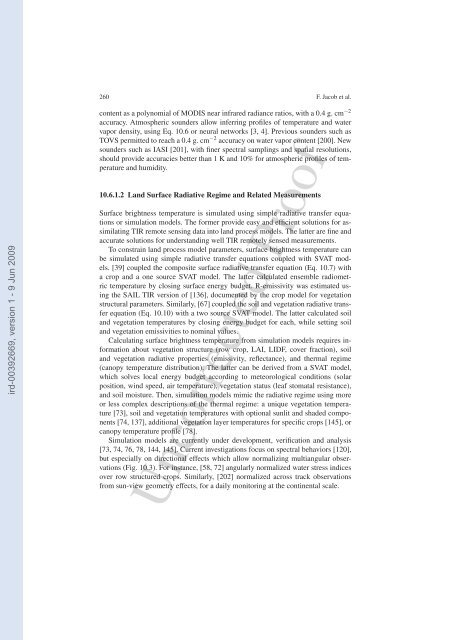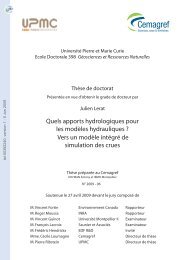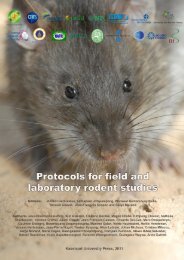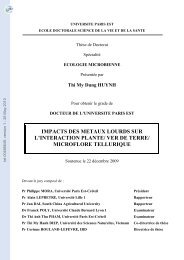Modeling and Inversion in Thermal Infrared Remote Sensing over ...
Modeling and Inversion in Thermal Infrared Remote Sensing over ...
Modeling and Inversion in Thermal Infrared Remote Sensing over ...
You also want an ePaper? Increase the reach of your titles
YUMPU automatically turns print PDFs into web optimized ePapers that Google loves.
260 F. Jacob et al.ird-00392669, version 1 - 9 Jun 2009content as a polynomial of MODIS near <strong>in</strong>frared radiance ratios, with a 0.4 g. cm −2accuracy. Atmospheric sounders allow <strong>in</strong>ferr<strong>in</strong>g profiles of temperature <strong>and</strong> watervapor density, us<strong>in</strong>g Eq. 10.6 or neural networks [3, 4]. Previous sounders such asTOVS permitted to reach a 0.4 g. cm −2 accuracy on water vapor content [200]. Newsounders such as IASI [201], with f<strong>in</strong>er spectral sampl<strong>in</strong>gs <strong>and</strong> spatial resolutions,should provide accuracies better than 1 K <strong>and</strong> 10% for atmospheric profiles of temperature<strong>and</strong> humidity.10.6.1.2 L<strong>and</strong> Surface Radiative Regime <strong>and</strong> Related MeasurementsSurface brightness temperature is simulated us<strong>in</strong>g simple radiative transfer equationsor simulation models. The former provide easy <strong>and</strong> efficient solutions for assimilat<strong>in</strong>gTIR remote sens<strong>in</strong>g data <strong>in</strong>to l<strong>and</strong> process models. The latter are f<strong>in</strong>e <strong>and</strong>accurate solutions for underst<strong>and</strong><strong>in</strong>g well TIR remotely sensed measurements.To constra<strong>in</strong> l<strong>and</strong> process model parameters, surface brightness temperature canbe simulated us<strong>in</strong>g simple radiative transfer equations coupled with SVAT models.[39] coupled the composite surface radiative transfer equation (Eq. 10.7) witha crop <strong>and</strong> a one source SVAT model. The latter calculated ensemble radiometrictemperature by clos<strong>in</strong>g surface energy budget. R-emissivity was estimated us<strong>in</strong>gthe SAIL TIR version of [136], documented by the crop model for vegetationstructural parameters. Similarly, [67] coupled the soil <strong>and</strong> vegetation radiative transferequation (Eq. 10.10) with a two source SVAT model. The latter calculated soil<strong>and</strong> vegetation temperatures by clos<strong>in</strong>g energy budget for each, while sett<strong>in</strong>g soil<strong>and</strong> vegetation emissivities to nom<strong>in</strong>al values.Calculat<strong>in</strong>g surface brightness temperature from simulation models requires <strong>in</strong>formationabout vegetation structure (row crop, LAI, LIDF, c<strong>over</strong> fraction), soil<strong>and</strong> vegetation radiative properties (emissivity, reflectance), <strong>and</strong> thermal regime(canopy temperature distribution). The latter can be derived from a SVAT model,which solves local energy budget accord<strong>in</strong>g to meteorological conditions (solarposition, w<strong>in</strong>d speed, air temperature), vegetation status (leaf stomatal resistance),<strong>and</strong> soil moisture. Then, simulation models mimic the radiative regime us<strong>in</strong>g moreor less complex descriptions of the thermal regime: a unique vegetation temperature[73], soil <strong>and</strong> vegetation temperatures with optional sunlit <strong>and</strong> shaded components[74, 137], additional vegetation layer temperatures for specific crops [145], orcanopy temperature profile [78].Simulation models are currently under development, verification <strong>and</strong> analysis[73, 74, 76, 78, 144, 145]. Current <strong>in</strong>vestigations focus on spectral behaviors [120],but especially on directional effects which allow normaliz<strong>in</strong>g multiangular observations(Fig. 10.3). For <strong>in</strong>stance, [58, 72] angularly normalized water stress <strong>in</strong>dices<strong>over</strong> row structured crops. Similarly, [202] normalized across track observationsfrom sun-view geometry effects, for a daily monitor<strong>in</strong>g at the cont<strong>in</strong>ental scale.Uncorrected Proof
















